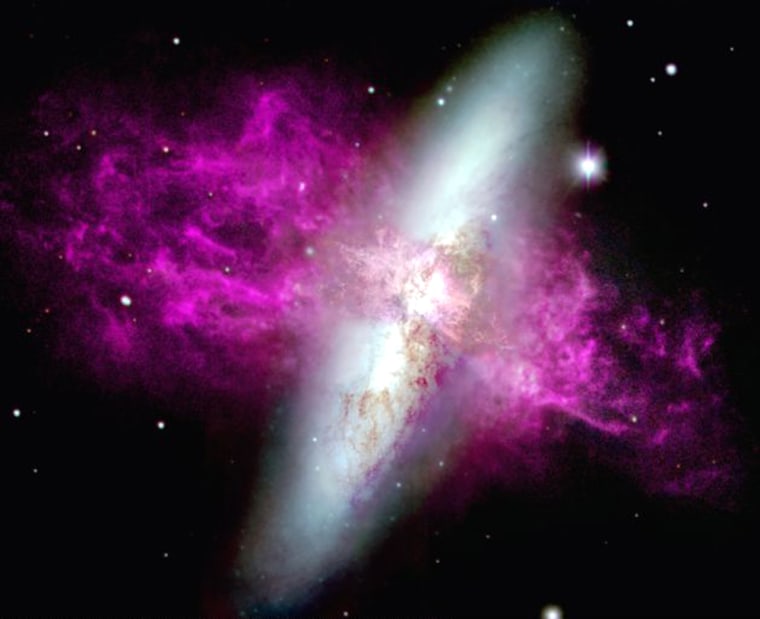A shower of hot gas spewed from a galaxy loaded with pockets of intense star formation offers a window to the more violent early universe.
The rapid-fire starbirth in M82 was triggered by a collision with another galaxy, and the tremendous activity fuels a "cosmic hurricane ... traveling at more than a million miles an hour [447 kilometers per second] into intergalactic space," said Linda Smith of the University College London.
The gas travels in two opposite directions and extends thousands of light-years. Traced back to their sources, the two plumes are revealed to originate in the many separate clumps of star formation and the quick, explosive deaths of massive stars that generate new elements.
"Our goal here is to understand the structure of the wind's plumes, which are key factors in the evolution of this galaxy and the eventual pollution of nearby intergalactic space with new chemical elements," Smith said.
An image of the scene was released Friday. It was created by combining Hubble Space Telescope observations that detail the inner part of the galaxy with a view from the WIYN Telescope on Kitt Peak in Arizona, which showed the extended winds, explained Mark Westmoquette, also of the University College London.
Significant ‘superwinds’
It is not unusual to see jets or plumes of material escaping along the rotation axis of stars, a black hole or an entire galaxy. But M82 is noted for its "superwinds," as astronomers call the bipolar outflows.
"The M82 wind is made up of gas jets from multiple chimneys, each of which is relatively distinct," said Jay Gallagher of the University of Wisconsin-Madison, another member of the study team. "We hypothesize that these originate from individual star-forming clumps within M82."
Some of the clusters contain as much mass as a million suns packed within 30 light-years of space, Gallagher said earlier this month during a discussion of his group's work at an astronomy meeting at the Space Telescope Science Institute.
M82 is about 10 million light-years away, which is relatively close in space and time. Gallagher said the scene can help astronomers understand what occurred in the early universe, when starbirth was rampant. Because primordial galaxies are incredibly far away — billions of light-years — detailed examination of their structures is not practical with current telescopes.
Yet astronomers have seen enough to know that there are big differences between early galaxies and most of the mature galaxies closer by.
"Observations of the distant universe have really shown us now — and we have to confront this — that star formation in early epochs was really intense," Gallagher said. "The universe has gone from an intense mode of star formation in galaxies to a lazier mode nowadays."
So it is imperative, he said, to understand the mechanics of so-called starburst galaxies like M82.
Collisions and clumping
In particular, Gallagher told Space.com, the distinct clumping of star formation in M82 is thought to be similar to how it worked when some of the earliest galaxies were under construction.
The impetus for star formation in M82 came from a collision with another galaxy, M81, about 300 million years ago, astronomers say. Collisions were common when the universe was younger and smaller, and are thought to have played an important role in starbirth. Here's what happens in a typical collision:
"Huge amounts of gas are funneled into dense regions faster than the galaxy can get rid of it," Gallagher explained. "The galaxy overheats and explodes into stars."
